This Thai green curry with chicken and eggplant known as Gaeng Keow Wan is spicy, rich, and incredibly fragrant. Served over a bed of jasmine rice, it makes for a delicious and satisfying Thai meal.
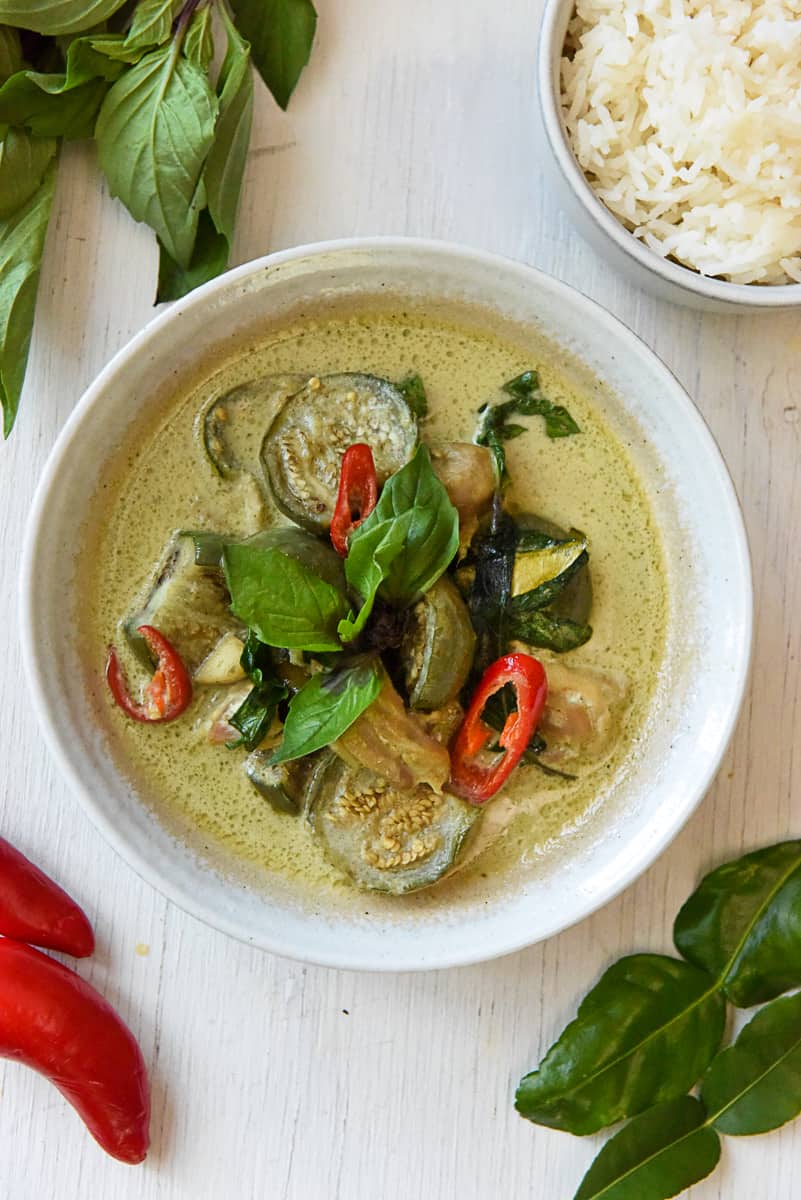
Every time my Thai in-laws come to visit, they prepare a wonderful array of delicious Thai foods. And always among the spread is this Thai green curry with chicken and eggplant known as Gaeng Keow Wan Gai. It is a classic Thai curry that never gets old, and is eaten almost as quickly as it's made!
Although Thai green curries can be made with any number of proteins or vegetables, this version with chicken and eggplant is one of my personal favorites. Both the chicken and the eggplant simmer in the curry sauce until they are super tender, picking up the wonderful curry flavor all the while. When the curry is done, they almost melt in your mouth, releasing all of the delicious flavors they picked up with each bite.
Jump to:
What is Thai Green Curry / Gaeng Keow Wan?
Green curry is one of many types of Thai curries. Green, red, yellow, massaman, and panang curries are some of the most well-known Thai curries in the West, although so many more than this exist.
Thai green curry, known as gaeng keow wan, starts with green curry paste. A typical green curry paste will include fresh green chilis, lemongrass, galangal, makrut lime zest, and shrimp paste in addition to a few other fresh herbs and spices. This paste is cooked with coconut milk until it's aromatic. Then the main ingredients and additional coconut milk, water, or broth are added to form a soup-like consistency. Fresh makrut lime leaves and Thai basil are added towards the end of cooking for a burst of fragrant flavor.
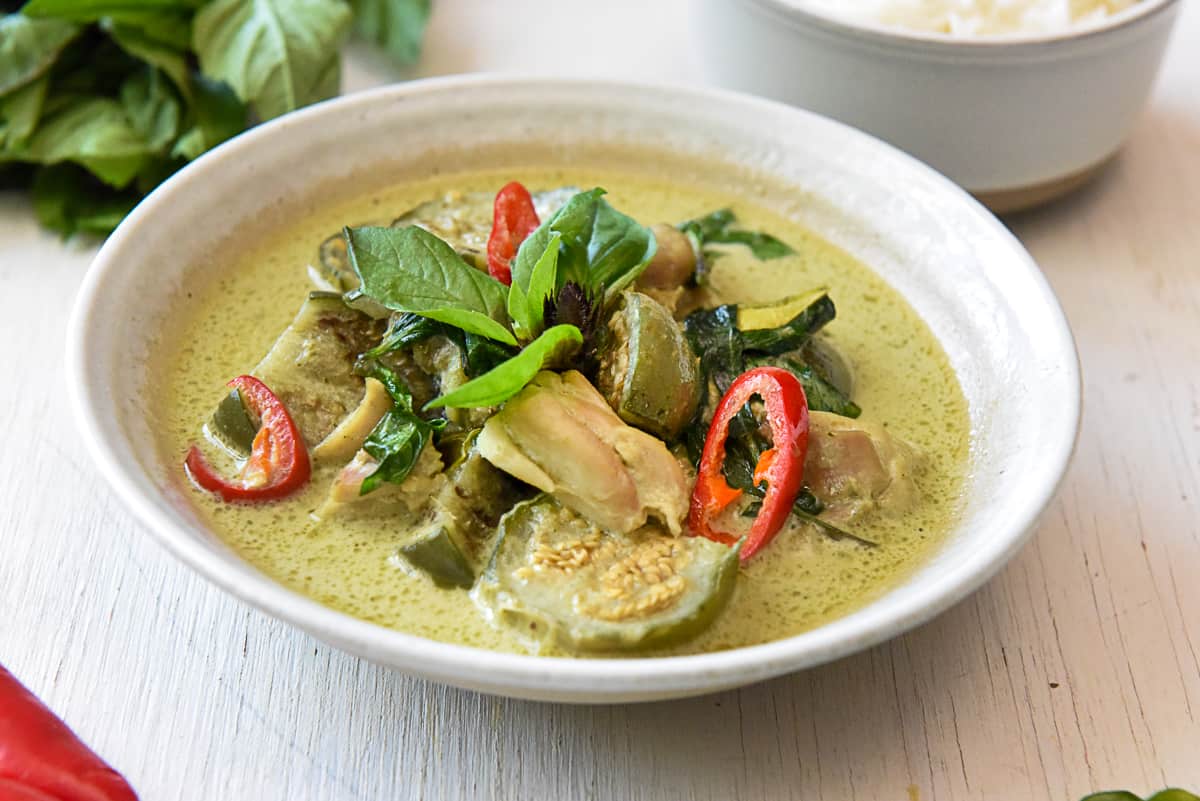
What does Gaeng Keow Wan mean?
In Thailand, green curry is known as "Gaeng Keow Wan". "Gaeng" is a word that's used to refer to a spicy soup or curry. "Keow" is the Thai word for green, and "wan" is the Thai word for sweet (see How to Interpret a Thai Menu for more Thai culinary word meanings). Put together, "Gaeng Keow Wan" translates to sweet green curry. The sweetness in this curry, however, is meant to be incredibly subtle. So subtle, in fact, that it's hardly noticeable amongst all of the spice, richness, and fragrance of the curry.
What is the best Green Curry Paste?
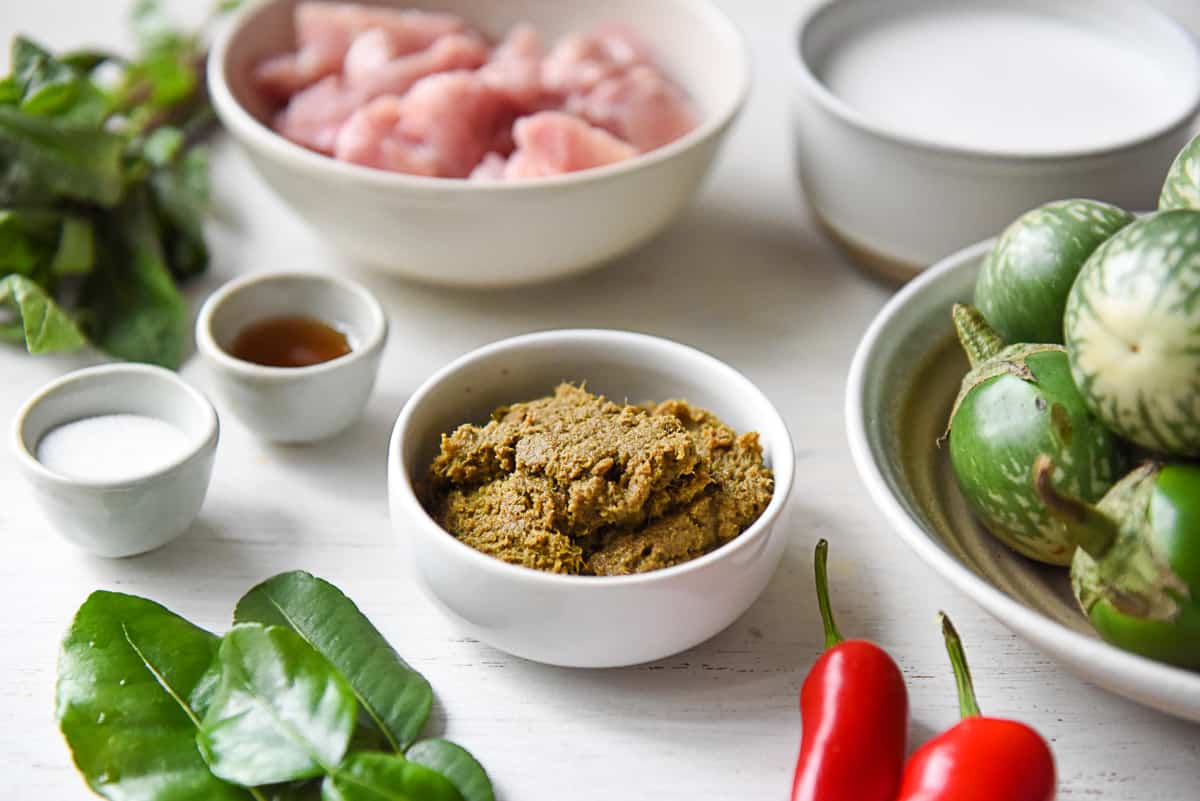
Thai green curry pastes can be made from scratch or bought from the store. Don't feel bad if you don't make your paste from scratch, I don't usually and most Thai people don't either! As such, there are many different brands of pre-made curry pastes available.
I conducted a Thai Test Kitchen taste test of several of the more common green curry paste brands to answer the question, "Which curry paste brand is best?". Fortunately, we found that all of the curry pastes we tried resulted in a decent Thai green curry. However, our top three favorite brands of Thai green curry paste were Mae Anong, Mae Ploy, and Maesri. Each brand of curry paste has slightly different flavors, so you'll want to taste your curry as it cooks and adjust the saltiness and sweetness accordingly.
How Much Curry Paste Should I Use?
The amount of curry paste you use will depend on your spice tolerance. This recipe calls for two tablespoons of curry paste, which, for most of the common curry paste brands, will result in a spicy curry for the American palate. When my Thai in-laws make this green curry, they use half a package of Mae Anong green curry paste or one and a half cans of Maesri green curry paste, and the result is definitely more of a Thai level of spice. If you prefer less spice, I'd recommend starting with one tablespoon of curry paste.
Ingredients
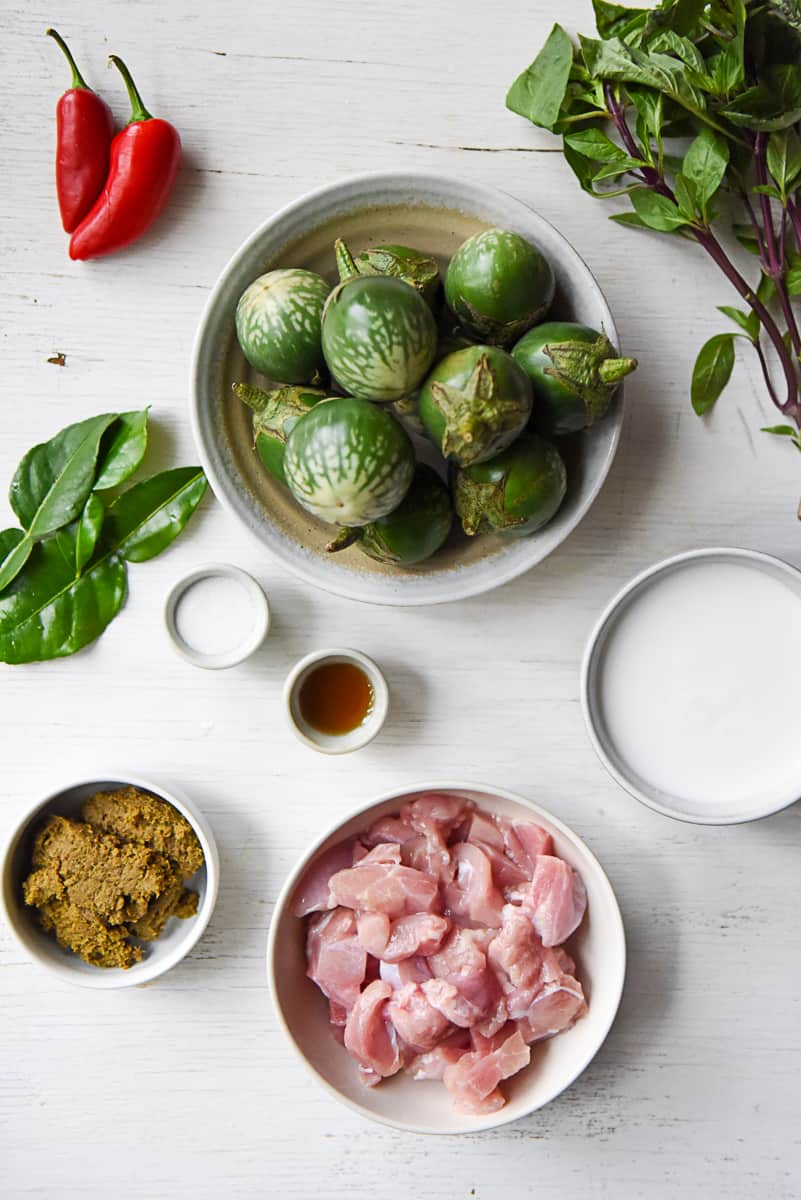
In addition to a good green curry paste, you'll need the following ingredients to make Thai green curry with chicken and eggplant:
- Coconut milk: Coconut milk helps to offset the spiciness of the curry, and adds a creamy richness to the dish. Regular canned coconut milk works well. I would not recommend using any variation such as sweetened coconut milk, coconut cream, or lite coconut milk. If you're feeling adventurous, you could squeeze your own coconut milk and make green curry with this recipe.
- Chicken: Boneless, skinless chicken thighs work really nicely in this recipe. Slice into bite-sized pieces against the grain of the meat and allow to simmer until it's nice and tender.
- Water or chicken broth: Thai green curry is more soup-like in consistency than many western restaurants would lead you to believe. Water or chicken broth will help to dilute the rich coconut milk base and allow the main ingredients to cook until tender.
- Eggplant: In Thailand, small round green eggplant and pea eggplant are often used in this curry. However, long purple Japanese eggplant also work well. Note that if you are using purple eggplant, the skin will likely turn brown after simmering in the curry paste. If you'd like for it to stay purple, you can flash fry the eggplant separately, then add it to the curry towards the end of the cooking process.
- Makrut lime leaves: These distinctive lime leaves add a wonderful fresh, citrus flavor to Thai green curry. They are often sold at Southeast Asian grocery stores, and occasionally at pan Asian stores like Ranch 99. You can also buy them fresh online. They freeze well, so once procured, they can be stored for many months in a freezer-safe bag. To use, simply wash, fold in half to strip the central vein away, and then tear in half again and add to the curry.
- Thai basil leaves: Thai basil adds a wonderful freshness and aroma to the spice of the green curry. If you don't have access to Thai basil, regular basil would likely work as a substitute. The leaves should be washed and added towards the end of the cooking process.
- Red pepper: I like to add red pepper slices for a little extra color, but these are definitely optional.
- Fish sauce: Fish sauce adds saltiness to the curry. How much fish sauce you need, or whether you need it at all, will depend upon which curry paste you use. I often use Mae Anong brand green curry paste, and add 1 teaspoon of fish sauce to help round the curry out.
- Sugar: Although green curry in Thai is "gang keow wan", with "wan" meaning sweet, Thai green curry is not meant to be very sweet. Half a teaspoon of white granulated sugar is all that's needed to bring out the subtle sweetness of the chicken and eggplant in this dish.
Instructions
Many Thai curries follow the same basic steps (see How To Make Thai Curries). This Thai green curry with chicken and eggplant is no exception. Follow these six steps and you'll have a delicious green curry in no time!
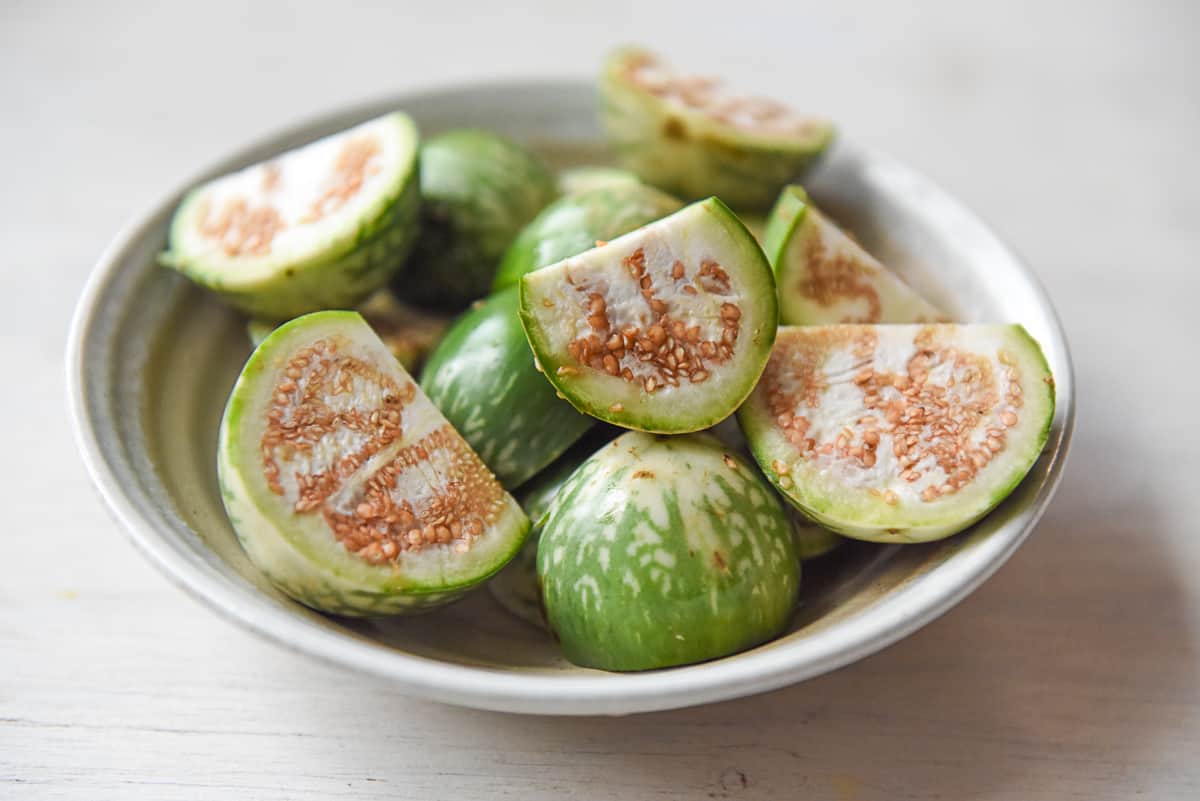
Prepare the Ingredients: Cut the chicken into bite-sized pieces. Remove the stems of the eggplant and cut into halves. Slice the red pepper diagonally. Remove the Thai basil leaves from the stems. Devein the kaffir lime leaves and tear in half.
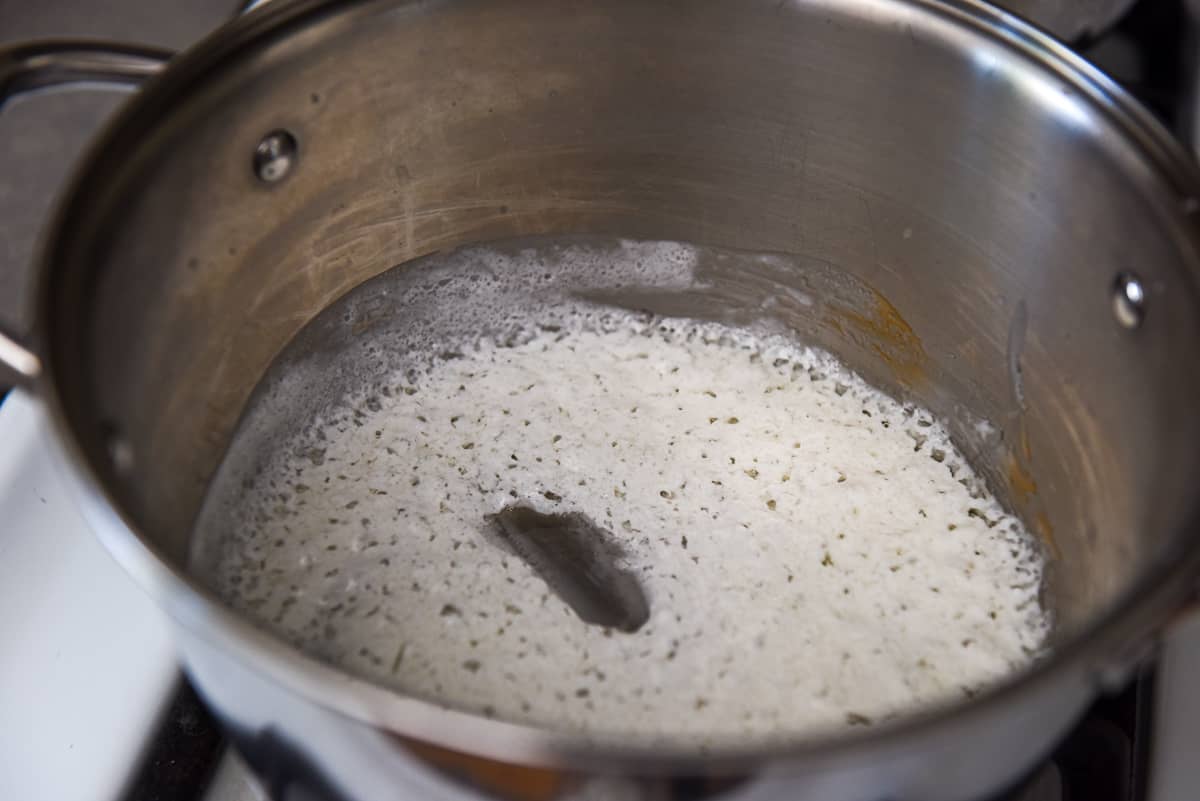
Break the Coconut Milk: When heated undisturbed, coconut milk will separate into oil and milk layers. You want this separation, as an oily sheen on a Thai curry is considered to be a good thing.*
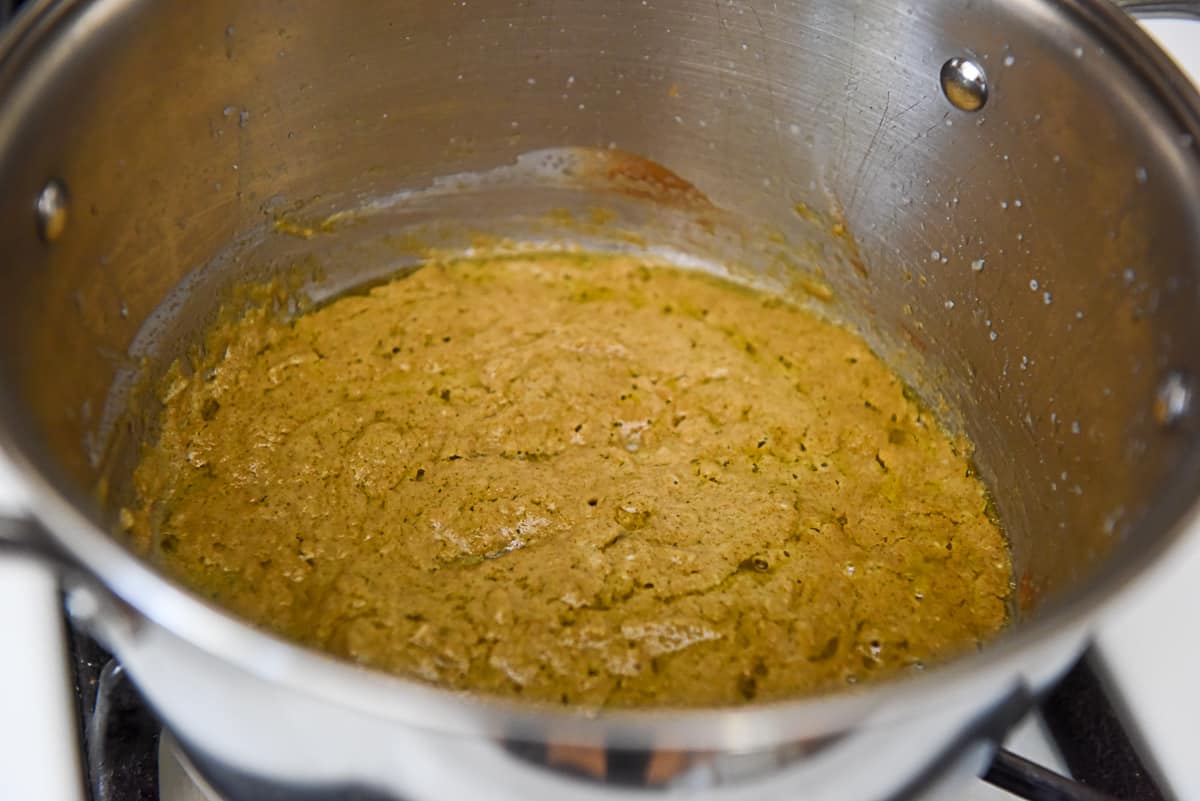
Fry the Curry Paste: Once your coconut milk has separated, add the green curry paste. Fry it in the coconut milk until it is very fragrant, being sure to stir it so that it doesn't burn. This usually takes about 3-5 minutes.
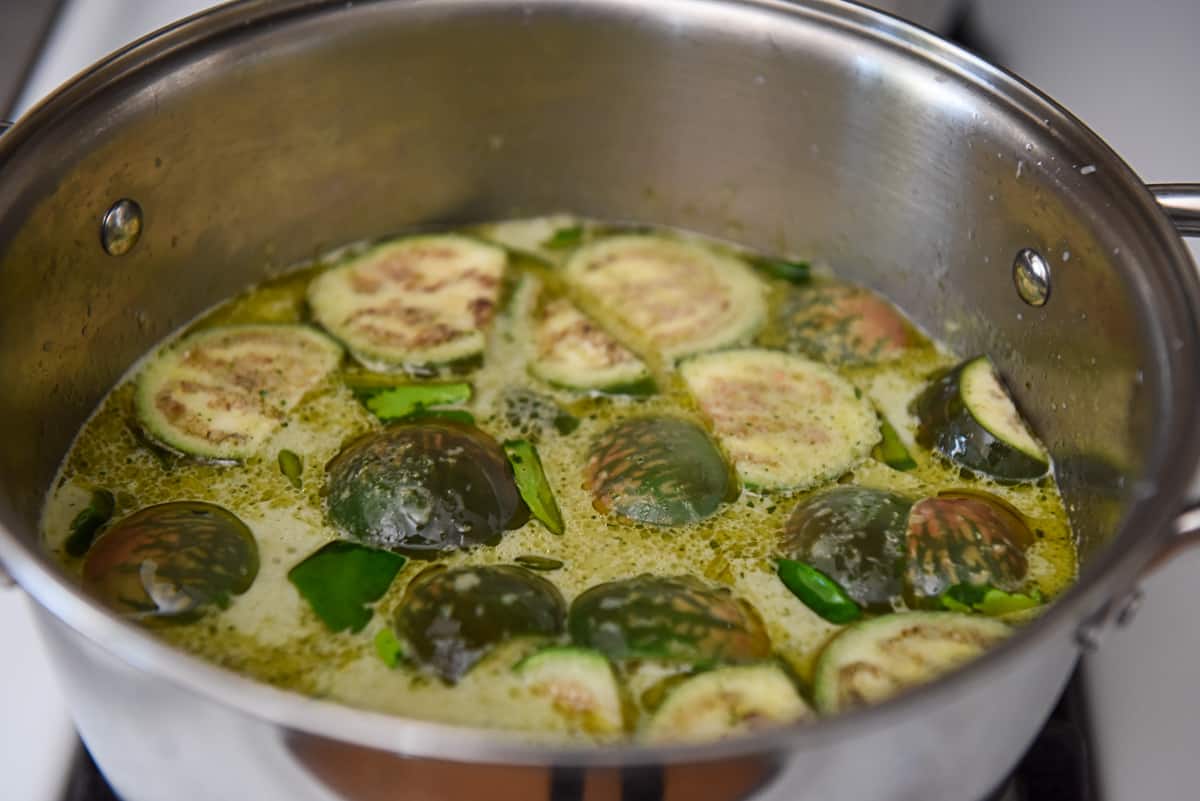
Add the Main Ingredients: Add the chicken, coat it in the curry paste, and cook until it is cooked through. Then add water or chicken broth and the eggplant. Allow the curry to come back to a simmer and cook until both main ingredients are nice and tender.**
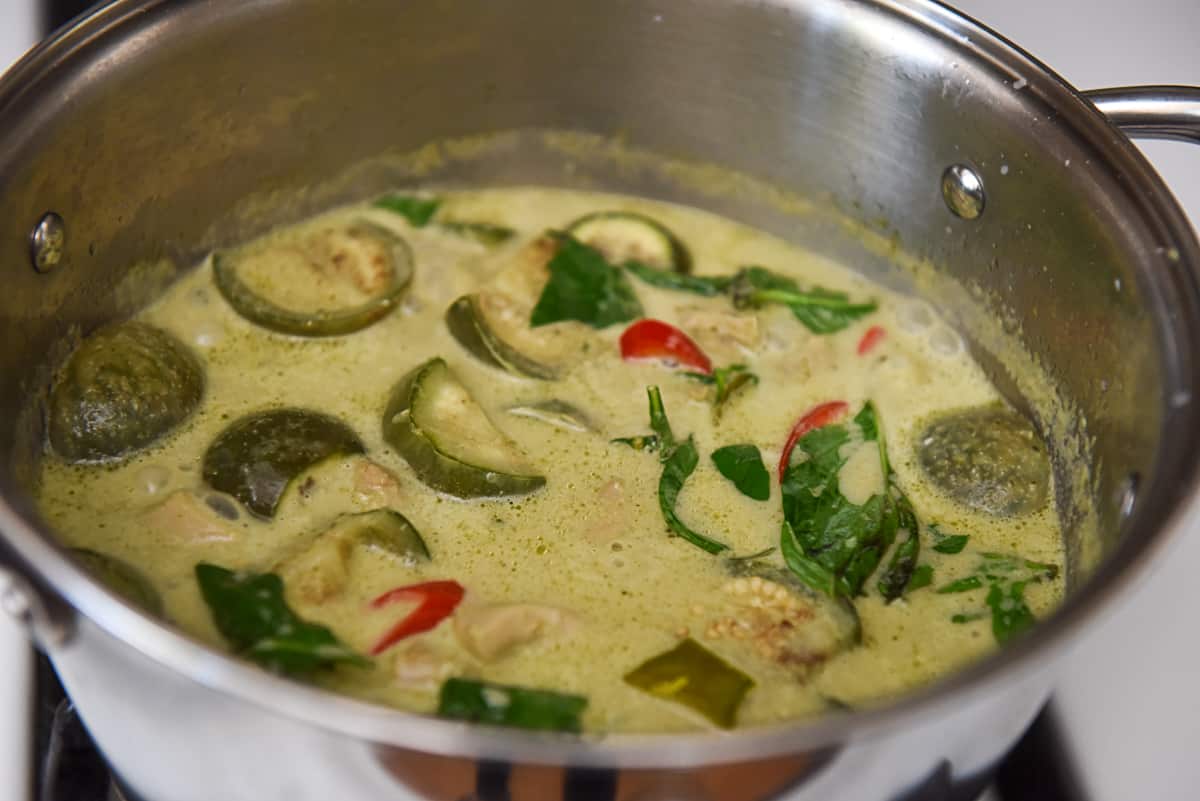
Boost the Flavor with Herbs: I often add the makrut lime leaves to the curry while the main ingredients are simmering so that its flavor can infuse the curry. The Thai basil leaves (and red peppers, if using) should be added a little closer to the end of the cooking process.

Adjust the Seasonings: Taste the curry and adjust the seasonings with fish sauce and sugar as necessary. Some curry pastes will not need any adjustment at all, and others might require a good amount. I add 1 teaspoon of fish sauce and ½ teaspoon of sugar when using Mae Anong green curry paste.
NOTES:
* You should be aware that canned coconut milk has added homogenizers that make it harder to "break". Some separation is still possible, but it won't be as pronounced as using fresh coconut milk. You can add some mild flavored oil if you like.
**You may need to add more water or broth, depending on how long it takes for the eggplant to cook.
Serving Suggestions
This green curry with chicken and eggplant is meant to be quite spicy and flavorful. This is so that it can flavor the plain jasmine rice that it's served with. You can serve the curry on top of a bed of jasmine rice, or in a separate bowl so that diners can add as much to their rice as they like. As an alternative to jasmine rice, this curry is also delicious when served over khanom jeen noodles (I often use somen noodles as an easier-to-find substitute).
Variations
Although chicken and eggplant is a classic combination, Thai green curry can be made with many different proteins and vegetables. This green curry with fish works well as the flavors of the curry permeate the flakey white fish. Pork, beef, and fried firm tofu are also all good protein options.
Any number of vegetables work well in Thai green curries. Some of the more common options in Thailand include eggplant, pea eggplant, bamboo shoots, and baby corn. In the West, carrots, broccoli, squash, zucchini, and snow peas would all be good options.
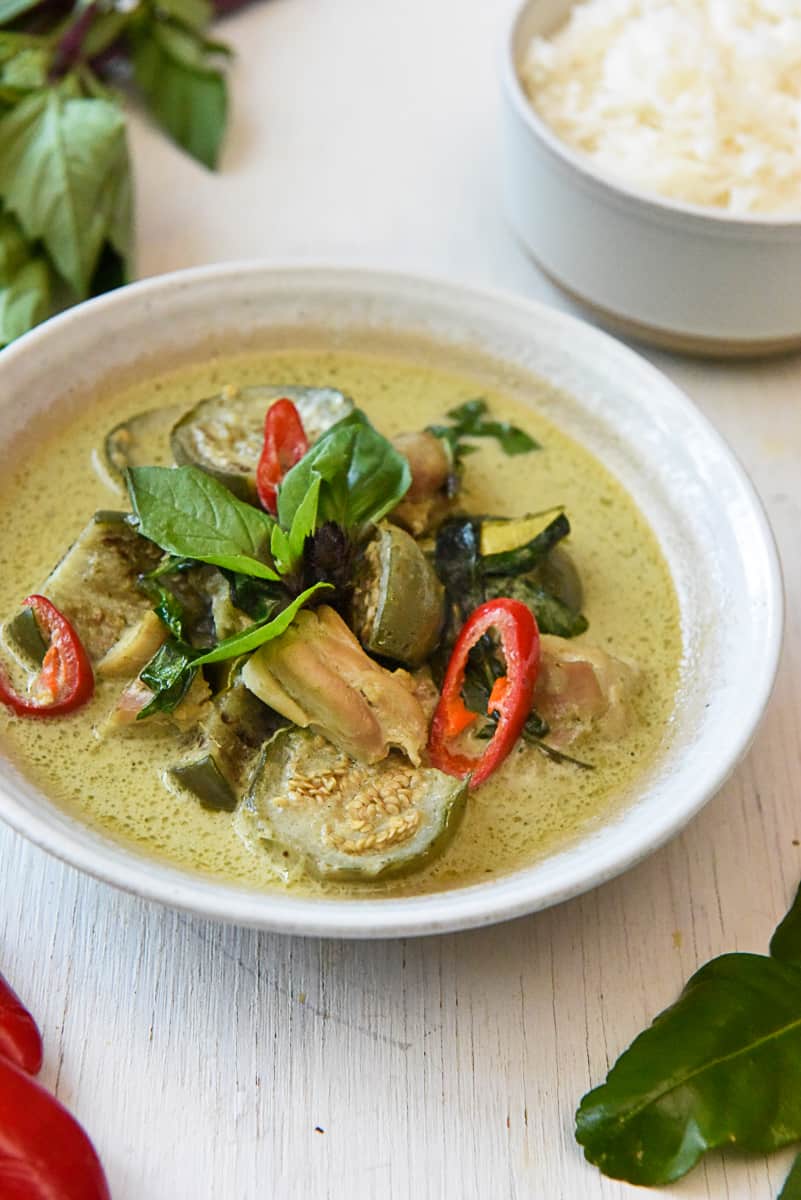
Recipe

Green Curry with Chicken and Eggplant | Gaeng Keow Wan Gai | แกงเขียวหวานไก่
Ingredients
- 1 cup coconut milk divided into ⅓ and ⅔ cups
- 2 Tablespoons green curry paste
- ½ cup chicken sliced thinly
- 1-2 cups water
- 2 makrut lime leaves deveined and torn
- 2 cups Thai eggplant cut into halves
- 1 red pepper sliced on the diagonal
- ½ cup Thai basil leaves
- 1 teaspoon fish sauce
- ½ teaspoon sugar
Instructions
- Prepare the Ingredients: Cut the chicken into thin bite-sized pieces, against the grain of the meat. Remove the stems of the eggplant and cut into halves. Slice the red pepper diagonally. Remove the Thai basil leaves from the stems. Devein the kaffir lime leaves and tear in half.
- Break the Coconut Milk: Open a can of coconut milk and gently scoop the top layer of cream (~⅓ cup) into a saucepan. Save the thinner milk at the bottom of the can for later. Heat the cream over medium high heat until it starts to separate into an oily layer and a milky layer.
- Fry the Curry Paste: Add the green curry paste and mix into the coconut milk until incorporated. Continue to fry the paste until it is very aromatic, approximately 3-5 minutes.
- Add the Main Ingredients: Add the chicken, coat in the curry paste, and allow to cook until it is cooked through. Then add the rest of the coconut milk and 1 cup of water and bring back to a simmer. Add the eggplant and kaffir lime leaves and cook until tender. Depending on how long it takes for the eggplant to cook, you may need to add another ½ to 1 cup of water so that the curry remains soup-like in consistency. Once everything is cooked through and tender, add the red pepper slices and Thai basil leaves.
- Adjust the Seasonings: Taste the curry and see if additional seasonings are needed. If they are, add fish sauce and/or sugar to round out the curry.
- Serve: Remove the curry from the heat. Serve with jasmine rice or khanom jeen noodles.


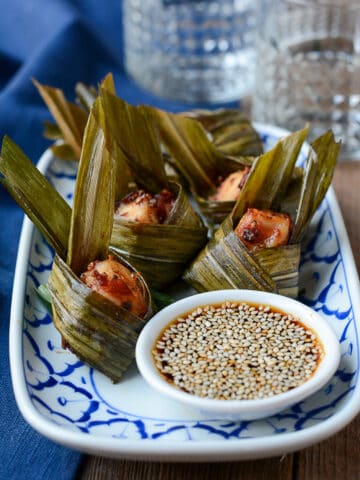
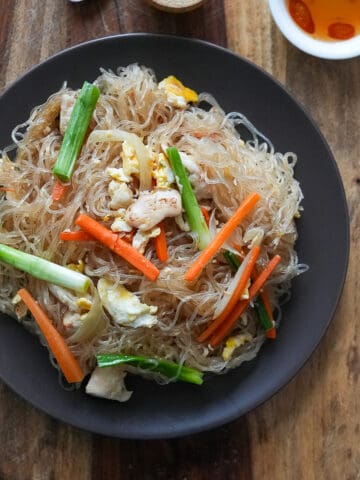
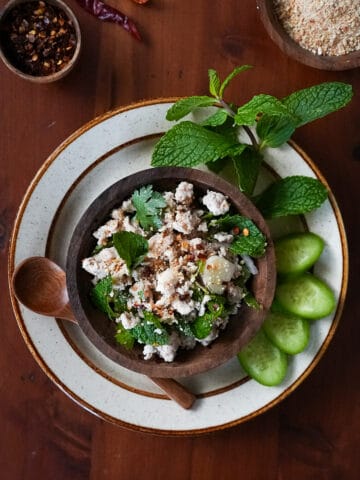
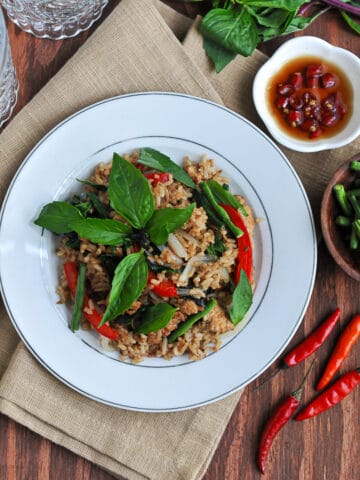
Manda
Hi Rachel,
I just stumbled across your website (my goal this year is to learn some good thai home cooking) and I love all the recipes you h have on here. I was wondering if you've ever tried making your curries in a crock pot and if so how would you adjust the recipe?
Thanks!
Rachel
Hi Manda, thanks for the comment! I haven't tried making curry in a crock pot, so unfortunately don't have any advice to give you. Best of luck!
Jessica L.
Made this last night-- delicious! Two questions: The step for cooking the coconut milk until it separates, is it supposed to splatter so much? Could you recommend other vegetables that would go well in this dish? I look forward to making another dish from your blog soon.
Rachel
Hi Jessica, glad you liked it! The coconut milk does tend to splatter a lot... Turning the heat down just a bit helps. As for vegetables, I believe Thai eggplant and pea eggplant are most commonly used. I bet bamboo shoots would work really well too though.
Rachel
Hi Susan, I prefer the Mae Anong brand of curry pastes (links are on the pantry page). I haven't yet tried to make my own, but am thinking that I should try it out one of these days soon!
SusanQ.
Could you share the brand name of your favorite green curry paste? (Or do you make your own.) Thanks for your wonderful recipes and photos.
Rachel
Glad you enjoyed it, Michael! I totally agree with you - basil and kaffir lime leaves make all the difference in Thai curries. For the eggplant, the skin definitely holds up more than say, an Italian eggplant, but shouldn't be particularly tough. May be worth cooking it for a little longer next time...
Michael B
Hi Rachel: I tried this and the flavors are wonderful. For the first time I found Thai Eggplant exactly as you prescribe (kaffir leaves still allude me). After a lot of cooking, the skins of the eggplants remained a bit tough and not tender. Is this typical or did I not cook them long enough.
I also found the Thai Basil at the great Asian market I visited. It really makes a big difference in a green curry dish ( I have made something similar many times without it and it just isn't the same).
Thank you for your blog.
Elizabeth Dehghani
Kaffir leaves can be ordered from http://www.silkroadspices.ca. Good luck!